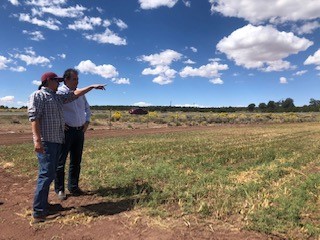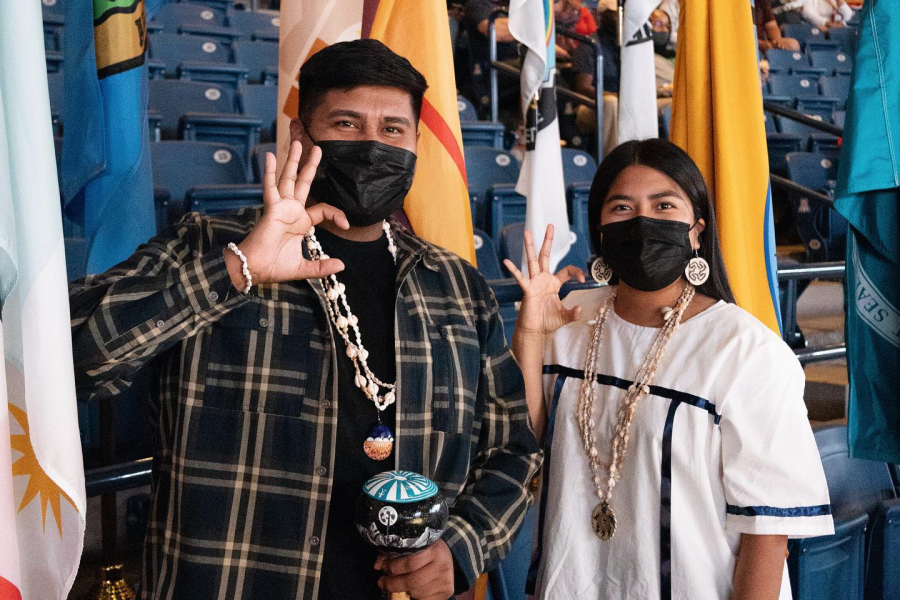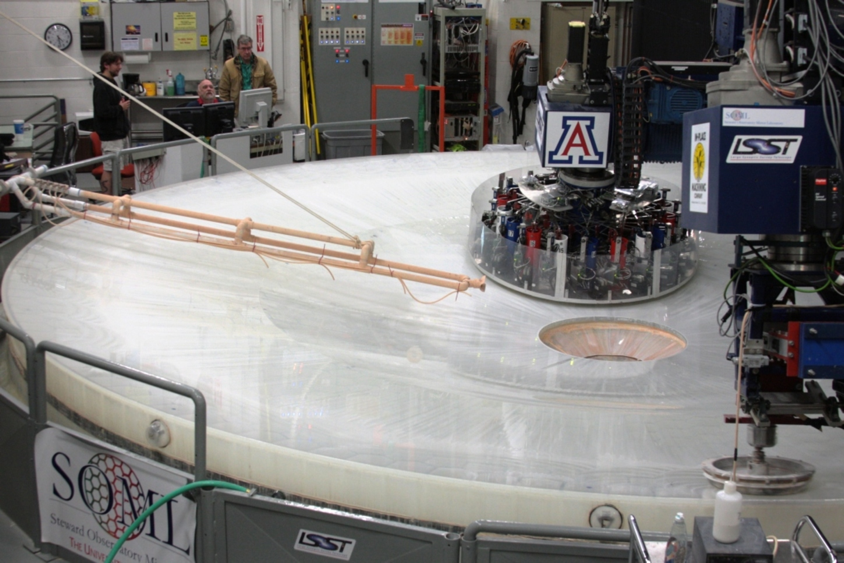Karen Francis-Begay is a PhD candidate in her last semester at the University of Arizona for her doctorate in higher education. By the end of the year, she will have been one of the many Indigenous students that have made the UA the No. 1 ranked institution to award doctoral degrees to Native Americans between 2016 to 2020, according to the National Science Foundation.
But this news is not a coincidence. If anything, it shows the university’s direct efforts to recruit, retain and involve Native American students at the UA.
“It’s a true reflection of the university, and we still have more potential to tap. So even though we’re ranked No. 1 now, our goal is to continue to grow and be the leader in not only awarding doctoral degrees, but all professional degrees moving forward,” said Nathan Levi Esquerra, the senior vice president for Native American Advancement and Tribal Engagement, which focuses on fostering relationships with tribes outside of the university.
RELATED: UA program for Indigenous students studying education receives $2.4M in new funding
The UA has a long history and relationship with Native American students.
When Francis-Begay first started at the UA for her Bachelor of Science in public administration in 1983, she said there were less than 300 Native American students at the university. And now, due to the university’s continual support and expansion of Native American programs, there are 1,659 students, according to her.
The UA has a one-of-a-kind approach to building its Indigenous community on campus. On every level, they are making an effort to meet Native Americans’ needs — from students, to teachers, to higher-up positions and programs with focuses specifically on Native American students.
“Fellowships, dedicated mentors and university-wide initiatives like the Indigenous Resilience Center help create an environment where Native American students can thrive, and this ranking is a clear reflection of the impact of these and other efforts,” said President Dr. Robert C. Robbins in a UA News media release.
Native American spaces on campus
The UA has positioned itself to be among the leading institutions for Indigenous students. They have spaces that allow these students to gather, as well as a multitude of resources available to them.
Clubs and organizations like the Tohono O’odham Student Association are among many others that exist and thrive on campus to foster a sense of community for these students.
After a long pandemic year, the Tohono O’odham Student Association is finally starting their regular meetings back up, this time over Zoom.
“We really wanted all of the members to focus on themselves and their families and staying safe and healthy,” said Jacelle Ramon-Sauberan, a mentor for the association and PhD candidate in the American Indian studies program. She has also been at the university since her bachelor’s degree in journalism with a minor in American Indian studies.
This is a club that allows for Indigenous students to have a space to connect with each other and with other resources on campus that the leaders of the group push towards students.
“You’ve got to find a support system. You’ve got to find those that can be there for you and somebody you can lean on during hard times,” Ramon-Sauberan said.
RELATED: Cultural centers provide support and connection for UA students
Ramon-Sauberan has been a part of TOSA since its inception, moving through each role in the club until she was established as a mentor. She herself has been a Wildcat for most of her educational career and can vouch for the resources on campus available to her and other Indigenous students.
“The American Indian studies department has been a part of my college career since I was an undergrad because I have my minor in American Indian studies, and then my master’s in American Indian studies and now my PhD,” Ramon-Sauberan said. “The professors and the support staff have been amazing and super supportive and really open to helping you and being there for you.”
She recalled earlier that day that she had been invited by a previous professor to teach a class and called it an “example of opportunity” on campus.
The Indigenous Teacher Education Program, which the Daily Wildcat has previously done a story on, is another UA program that sponsors and supports Indigenous students in their studies even after they have graduated. ITEP’s goal is to get more Indigenous teachers back into their communities and to support these students all throughout their last two years completing their bachelor’s degrees in elementary education.
The Indigenous Resilience Center
The newest partnership that has launched between the university and tribal communities in Arizona is the Center to Advance Resilience of Native Nations, which launched in September.
The UA will work directly with tribal leaders to address environmental issues, which can range from renewable energy to sustainable agricultural practices to sustainability, said IRC director Karletta Chief. She is also a distinguished outreach professor and an associate professor of environmental science.
“We’re partnering and leveraging our expertise in [science, technology, engineering and math] regarding sustainable solutions that are technologically based and connecting that with the traditional values of Indigenous communities in respectful ways that are ethically responsible and culturally sensitive,” Chief said.
Chief emphasized that the IRC is driven by the priorities and needs of the tribal communities they are partnering with. While this semester has focused on the semantics of planning, the spring semester will entail talks between the university and tribal leaders to make sure that their voices are heard in the process.
As a PhD graduate herself, Chief said she chose the UA because she knew that it was a land grant university that had a commitment to tribal communities. Through the school, she said she gained the valuable experience needed to be in the position she is now.
Like many other professors on campus, she said she wants to open the doors for the Indigenous students that follow.
“My goal as a professor is that students don’t have to wait until they’re professional or until they’re professors to do this kind of work, but that they can have that interdisciplinary training to do community-based work as a student and be able to make change,” Chief said.

Native American Initiatives
In addition to completing her studies, Francis-Begay serves as the assistant vice provost for Native American Initiatives, one of the programs at the UA for Indigenous students. She is a trailblazer for those who will follow in her footsteps.
“It’s probably the only position of its kind in the whole country,” Francis-Begay said.
What makes her position unique is that it allows her to express her concerns as well as those of Indigenous students on campus directly to the provost, she said. This leaves less space for watering down issues as it allows a direct connection between the two parties.
Francis-Begay focuses not only on student experience and retention, but also on the Native faculty experience and retention at the university.
“We’ve become a magnet, and we’re drawing students from all over the United States who want to come and study here,” said Francis-Begay. “The faculty are role models, and they’re taking students under their wing and guiding them, so faculty have a lot to do with our increasing numbers here but also why students stay and go on to completion.”
The NAI were born out of student advocacy on campus, Francis-Begay said. Students were demanding attention to the challenges they faced as Indigenous students on a historically white campus, so they advocated to the president and provost to create a position at a high level that addressed their concerns.
“When students come to the university, they should be able to focus primarily on their academics without worrying about housing, financial aid or finding their community on campus,” Francis-Begay said. “We’re simply trying our best to provide a home away from home environment. So those are things that we’re trying to make improvements upon so that they can dedicate all of their time and effort on their degree.”
Rocky relationship between the Indigenous community and institutional leaders
Although the UA has made leaps in the programs they offer Indigenous students, there is also a problematic past between Indigenous students and Robbins.
In November of 2019, Robbins went under fire after he made an offensive comment in front of a SOAR class about his alleged Cherokee ancestry saying that he did not want to “pull an Elizabeth Warren.” He added that he had taken a DNA test to see if he had any Cherokee ancestry and that it had come back negative but that he was going to take another one to double-check “because of his very high cheekbones.”
“It wasn’t necessarily about the stereotypes that were brought forth in the comments,” said Felisia Tagaban, a graduate student in the College of Education who had been in the class when Robbins made the remark. “It was more the mindset behind the comment, the lack of information around the comments that was most offensive, and so we actually use that interaction to help to bring up these deeper systemic issues concerning a lack of funding and a lack of support.”
Tagaban also mentioned another confrontation with Provost Liesl Folks in which she shared some comments that were “very unexpected and hurtful.”
Following Robbin’s remarks, Tagaban and other Native students formed Voices of Indigenous Concerns in Education and wrote a letter to describe what they wanted to come out of the situation. The students sat down with Robbins and his leadership team to educate him on why his words were problematic as well as to give recommendations on how to better service Indigenous students and to hold him accountable for the commitments he made to the Native American student population.
“I think they may have shifted in terms of their individual perspectives. I don’t necessarily think, though, that it yielded this monumental sense of change that I think that we desperately need,” Tagaban said. “And I don’t want to be dismissive of their efforts, because I do think that their perspective shifted, but I think what we’re talking about as students is so much bigger than just one or two institutional leaders. It’s more like the system needs to change.”
Robbins later offered an apology but still, some students felt that it was forced.
“There was a lot of heat on the university from local and tribal communities,” said Trinity Marie Norris, a junior studying information science and eSociety. “I like to think it was genuine, but I think they could’ve done way better in apologizing.”
Tagaban acknowledged some improvement in the increasing support for Native students, citing her own position as proof of institutional commitment. She also added that the UA being built on Indigenous land warrants better treatment and free tuition for Native American students.
However, Norris mentions that there are still unmet needs in the Indigenous community on campus, like the hiring of a Native American student affairs director for different services that would support students. She highlighted the positive impact of the Native American student affairs office on her education and the support of the people she interacts with within the office.
“I definitely don’t think that it would be fair to say that the institution isn’t doing anything to support Native students. I think it’s more accurate to say they should be and could be doing much more,” Tagaban said.
NAI Efforts during the pandemic
During the pandemic, the university was able to show how much they truly valued their Native American students’ success.
Many Native American students had to travel back to their homes where they faced many challenges, like not having reliable internet or not having the proper software and hardware. Some students had to travel miles before they got to a place with enough stable signal to do all of the online work required of them.
“That really shed light on some of the education disparities that have been part of our lives for a very long time,” Francis-Begay said.
Francis-Begay underwent many projects to help Indigenous students. One of the first projects was simply finding a way to reach Native students who had moved to remote locations. If the UA couldn’t reach students through the internet, hopefully they were listening to the radio station.
“President Robbins did public service announcements over tribal radio. He conveyed a message of being concerned about their well-being,” Francis-Begay said. “And it was interesting, because a few of them did call me. A few of them did get a hold of me and said, ‘I just heard on the radio that you can help me.’”
Another project was putting together a laptop loan program through the Main Library for students who were in need of one. Another was creating a donation drive program for tribal communities in need.
RELATED: Q&A with Nathan Esquerra, UA’s first senior VP for Native American Advancement and Tribal Engagement
The UA being recognized as No. 1 in awarding doctorates to Native American students has come from the institutional changes and efforts before, during and after the pandemic that have given this community a voice to feel heard and appreciated, enough so that they stay through to graduation and can call the UA their home, just like Francis-Begay.
The UA is a beacon for Indigenous students wanting to give back to their communities through different channels. It draws not only students, but professors who want to see younger Indigenous students succeed, and that will help and support them to reach their educational goals.
“As you get higher up into academia, there’s less and less of us. And so, for being Native American and what has happened within American Indian history with education, this is our chance to take that back because education is power,” Ramon-Sauberan said. “We need more of our Native American Indigenous folks in academia. We need more professors, we need more lawyers, we need those role models.”
Follow Susan Barnett on Twitter









